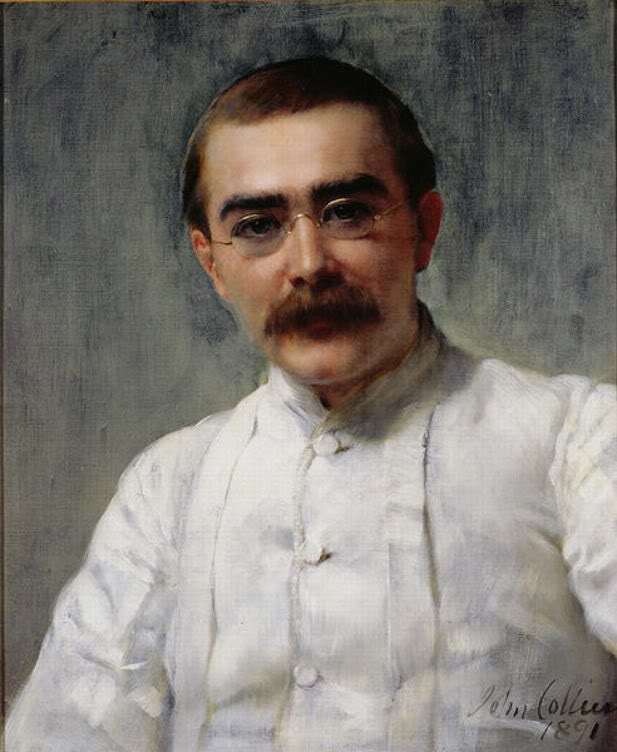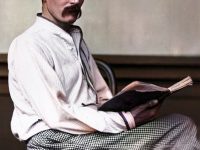
Rudyard Kipling (1865-1936) Portrait by John Collier
On December 30, 1865, English short-story writer, poet, and novelist Joseph Rudyard Kipling was born in Bombay, India. Kipling is best remembered for his tales and poems of British soldiers in India, and his tales for children.
“Now this is the Law of the Jungle—as old and as true as the sky;
And the Wolf that shall keep it may prosper, but the Wolf that shall break it must die.”
— Rudyard Kipling, The Second Jungle Book (1895)
Early Years
Rudyard Kipling was born at Bombay, India, to John Lockwood Kipling, himself an artist and principal of the Jeejeebyhoy Art School, and Alice Kipling. Family ties from his mother’s side include the famous painters Sir Edward Burne-Jones (one of the most important of the Pre-Raphaelites) and Sir Edward Poynter, but also Stanley Baldwin, a future Prime Minister. His early years in India, until he reached the age of six, seem to have been rather idyllic, but in 1871 the Kipling family left India to return to England. While John and Alice Kipling left again for India after 6 months, Rudyard and his younger sister were left as boarders with the Holloway family in Southsea. During his five years in this foster home he was bullied and physically mistreated, and the experience left him with deep psychological scars and a sense of betrayal.
In 1877 Kipling’s mother returned to England and collected him from ‘The House of Desolation’ as he grimly refers to the Holloway’s later in his autobiography. In 1878 Kipling was admitted to United Services College, a military school in Westward Ho, Bideford. He was wearing spectacles, for Kipling was nearly blind without them and his undiagnosed vision problems were the source of much grief from his schoolteachers. He learned to defend himself from bullies and settled into the life of a student. He was not awarded a scholarship for academic training.
Return to India and First Literary Success
In 1882 Kipling returned to India, where he worked for Anglo-Indian newspapers. Lockwood Kipling, who worked in Lahore as the director of an art school and museum, got him a job as subeditor at the Civil & Military Gazette. In 1887 he moved to the Allahabad Pioneer, a better paper which gave him greater liberty in his writing and for which he travelled the Indian subcontinent as a correspondent. At the same time his books became successful; by 1888 he had already published six volumes with short stories, among them Soldiers Three (1888). In style, the stories showed the influence of Edgar Allan Poe,[3] Bret Harte, and Guy de Maupassant.[4] But the subjects were Kipling’s own: Anglo-Indian society, which he readily criticized with an acid pen, and the life of the common British soldier and the Indian native, which he portrayed accurately and sympathetically. In his Plain Tales from the Hills (1888) he is giving us wonderful stories from Anglo-Indian life. A prolific writer, he achieved fame quickly.
Back in England and the U.S.
The following year, 1889, Kipling returned to England and settled in London, where he was accepted into several prestigious clubs. His literary friends and patrons included Henry Rider Haggard and Henry James. He quickly became famous for his realistic narratives and poems, in which he masterfully integrated the rhythms of colloquial language and slang, for example of soldiers. In 1890 his first novel The Light that Failed was published. In 1892 Kipling married Caroline Balestier, an American. Their honeymoon took the couple as far as Japan, but they settled on the Balestier estate near Brattleboro, Vermont, where they remained until 1899 and began some of the happiest years of Kipling’s life, during which he wrote some of his best work.
The Jungle Book
In 1894 appeared his Jungle Book, which became a children’s classic all over the world. The Jungle Book is a collection of stories and poems. The best-known stories in it are about Mowgli, a foundling who grows up with animals in the Indian jungle. The stories about Mowgli are close to the genre of the developmental novel as they show Mowgli’s growing up and consciousness from the playful child to the master of the animal world. Mowgli must learn that the laws of nature are hard and demand a high degree of responsibility. In the struggle with the forces of nature, with animals and with people, the child matures into a self-confident youth.
England Again
“Words are, of course, the most powerful drug used by mankind.”
— Rudyard Kipling, speech, quoted in The Times (February 15, 1923).
After quarrels with relatives, the Kipling family returned to England. In 1897, Kipling published the novel Captains Courageous: A Story of the Grand Banks, in which he processed experiences and impressions from America. The powerful style is influenced by Robert Louis Stevenson, but even surpasses him in its scarcity and concentration on the essential.[5] The title of his poem The White Man’s Burden of 1899, in which he transfigured the civilization of the “savages” into an ethical burden imposed on the “white man”, became a synonym of imperialism. Against the background of the Spanish-American War, in which the USA conquered Cuba and the Philippines, the poem is addressed to US President Theodore Roosevelt, with whom Kipling was personally acquainted. Kipling’s message is that modern, dynamic states like the USA must push back the stagnating European colonial powers like Spain and shoulder the burden for the development of the people in the colonies. The poem is considered one of the essential testimonies of imperialism; its title became proverbial.
Kim and the Nobel Prize for Literature
Kim (1901), the story of Kimball O’Hara and his adventures in the Himalayas, is perhaps his most felicitous work. The son of an Irish soldier, Kim grew up as an orphan on the streets of Lahore, where he is considered a “native” despite his British ancestry. The novel is pervaded by a crime and espionage story, which serves as an occasion to let Kim travel through large parts of India and experience the respective customs. In 1902 he bought a house in Sussex which would remain his home in England until his death. In 1907 Kipling became the first English writer to receive the Nobel Prize for literature. In the following years Kipling travelled intermittently, and continued to publish stories, poems, sketches, and historical works.
World War I and Later Life
Originally, Rudyard Kipling showed a rather anti German attitude and was a strong supporter of the war. However, in 1915, his oldest son John died in the Battle of Loos at age 18. John had initially wanted to join the Royal Navy, but having had his application turned down after a failed medical examination due to poor eyesight, he opted to apply for military service as an Army officer. But again, his eyesight was an issue during the medical examination. In fact, he tried twice to enlist but was rejected. His father had been lifelong friends with Lord Roberts, former commander-in-chief of the British Army, and colonel of the Irish Guards, and at Rudyard’s request, John was accepted into the Irish Guards. In deep self-doubt and full of guilt, Kipling wrote the funeral proclamation for his son:
“If any question why we died, tell them, because our fathers lied”
After the First World War, Kipling worked intensively with the Commonwealth War Graves Commission. The optimism of earlier years gave way to an increasingly gloomy attitude, which is reflected in many of his late stories. His literary popularity declined. Kipling wrote into the early 1930s, although his success continued to decline.
Rudyard Kipling died on January 18, 1936, after a brain haemorrhage at age 70. He is buried in Westminster Abbey.
Daniel Bonevac, Lecture 14, Kipling, of UGS 303, [10]
References and Further Reading:
- [1] David Cody: Rudyard Kipling, a short biography, at victorianweb.org
- [2] Rudyard Kipling at nobelprize.org
- [3] The Mysterious Death of Edgar Allan Poe, SciHi Blog
- [4] Guy de Maupassant – Master of the Short Story, SciHi Blog
- [5] The Writings of Robert Louis Stevenson, SciHi blog
- [6] The Kipling Society website
- [7] Works by and about Rudyard Kipling at Wikisource
- [8] Rudyard Kipling at the Internet Speculative Fiction Database
- [9] Rudyard Kipling at Wikidata
- [10] Daniel Bonevac, Lecture 14, Kipling, of UGS 303, Ideas of the Twentieth Century, at the University of Texas at Austin, Fall 2013, Daniel Bonevac @ youtube
- [11] Timeline with works written by Rudyard Kipling, via Wikidata





